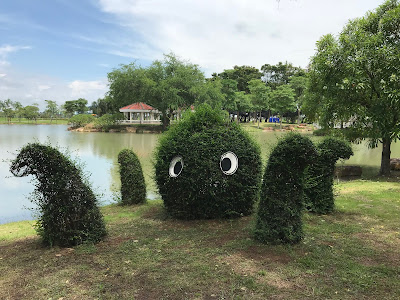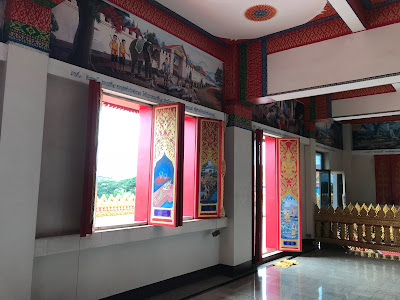When I tell Thai people that I have lived in Chiang Rai and Chiang Mai, they often ask me if I speak “คำเมือง” (kam meuang) which means the Northern Thai dialect. Unfortunately I have only learned a few words of คำเมือง since most Thai language resources are written in the central Thai language. As with most countries around the world, each area of Thailand has a unique history and sub-culture. The Northern part of Thailand is known for it’s relaxed pace of life, beautiful mountains and caves, and the ethnic diversity of the hill-tribe people. This area of Thailand is often referred to as “Lanna” (ล้านนา) which means “land of a million rice fields”. The famous Lanna kingdom thrived in the North of Thailand from the 13th to 18th century. Walking around Chiang Mai, it is easy to feel the ancient roots of the city, visible in the old city wall and gates and the numerous temples, many of which have been around for several hundred years.
The Old City of Chiang Mai is surrounded by an ancient wall with four gates and a moat. This is a picture of the west gate ("Suandok" gate), towards the hospital. For an even more detailed history of Chiang Mai city click here.
I had the opportunity to explore more of Northern Thailand a couple of weeks ago when I travelled to Chiang Rai province to visit friends from the University where I used to work. When my Thai friends ask me what I like to do in my spare time, I tell them that I love nature (ชอบธรรมชาติ chawp thamachaat) and I’m not really a city person (ไม่เป็นคนเมือง man ben kon meuang) so I was thrilled to be able to spend some time in the mountains of the North. I took the bus to Chiang Rai city which is located about three and a half hours Northeast of Chiang Mai and met up with my Thai friend. On Saturday we traveled to Doi Mae Salong which is a small Chinese-Thai village with a fascinating history and beautiful views of terraced tea plantations and mountains.
This is the famous Chiang Rai clock tower near the center of town. At night there are beautiful light displays.
Chiang Rai is a very "artsy" city with it's famous White Temple, Black Temple and now this Blue Temple. This was my first time visiting the blue temple, well-worth the trip.
A view of Doi Mae Salong village from the temple at the top of the mountain. This might be my favorite place in Thailand.
We climbed 719 steps to reach the top. No, we didn't count them all - we were told that number by a group of school boys we met coming down the mountain.
The next day we travelled to Chiang Khong, a small city on the banks of the Mekong River across from the Lao city of Huay Xai. Chiang Khong used to be a popular city for tourists taking the “slow boat” to Luang Prabang, Laos (a UNESCO world heritage site) but we were told this route has become less popular as more bus routes have become available. Chiang Khong is a sleepy town where time moves slowly alongside the unhurried flow of the Mekong river. I was sad to leave both of these places and return to the hustle and bustle of Chiang Mai, which my friend now calls “the second Bangkok” because of the rapid changes it has undergone in the last decade. I agree that Chiang Mai is not the same city that it was 10 yrs ago - there is much more traffic and modern businesses - but it does still retain a certain charm that is difficult to find in Bangkok.
"You do not really have places like this in the US, do you?" - quote from my Thai friend who lived in the US for a year as a Fulbright scholar. The peace and quiet of Chiang Khong is hard to match in the Western world.
We arrived in Chiang Khong quite late, went for a walk along the river in the dark. After eating delicious Mexican food. I can share the story of that restaurant later if you like...
During September, I had the opportunity to travel another region of Thailand - the “Isaan” region (also referred to as the “Northeast”) - to the city of Khon Kaen. I was fortunate to attend a conference called “Palliative Care in the ICU” (synchronicity?!?). The conference was led by a critical care physician from Australia and a pediatric pulmonologist from Khon Kaen who is one of pioneers of palliative care in Thailand. The Karunruk Palliative Care Center at Srinagarind hospital in Khon Kaen is now one of the most well-known and well-respected palliative care centers in Thailand. This trip to Khon Kaen was my first time visiting the Isaan (อีสาน) region of Thailand, although I had heard about it quite a bit when I was an English teacher in Chiang Rai.
There are certain stereotypes about Isaan that my Thai students would sometimes incorporate into their role plays - for example, that the region is poorer, less educated and less developed compared to other parts of the country (not sure if this was entirely appropriate for them to do but it seemed to be light-hearted with no hurt feelings). Certainly Khon Kaen has a different feel from other parts of Thailand. It is less “Westernized” with fewer English signs and chain restaurants, and feels more agricultural. Somewhat surprisingly, there is also a huge emphasis of dinosaurs given the discovery of many dinosaur fossils in the region (see article "Khon Kaen Land of Dinosaurs"). There is a rich history in the Isaan region that is a fusion of Thai, Lao and Cambodian cultures. Many people actually say that Isaan culture is more similar to Lao than central Thai culture (the Lao capital of Vientiane is a short 2 hr drive away).
One of many beautiful and creative city parks in Khon Kaen. I was amazed by how many lakes and ponds there were, reminded me a bit of home.
Altars are common in Thailand, I liked this lakeside altar with elephants and incense.
Inside the beautiful 9-story Phra Mahathat Kaen Nakohn temple. Each floor has different artwork (e.g. paintings, sculpture) and things like traditional Isaan musical instruments.
Outside Phra Mahathat Kaen Nakhon temple. I recommend visiting if you go to Khon Kaen!
View of Khon Kaen city from one of the upper floors of Phra Mahathat Kaen Nakohn.
**If you have any interest in the history of Southeast Asia and six minutes to spare, I recommend watching this interesting video that shows a time lapse map of all the kingdoms that existed in this region over the course of ~2000 years. Another great resource on Southeast Asia is the University of Wisconsin Madison’s Center for Southeast Asian Studies. I'm planning to write more about the projects I’m working on in Thailand next week, I thought I'd dedicate this post to the cultures and landscapes of Thailand.














